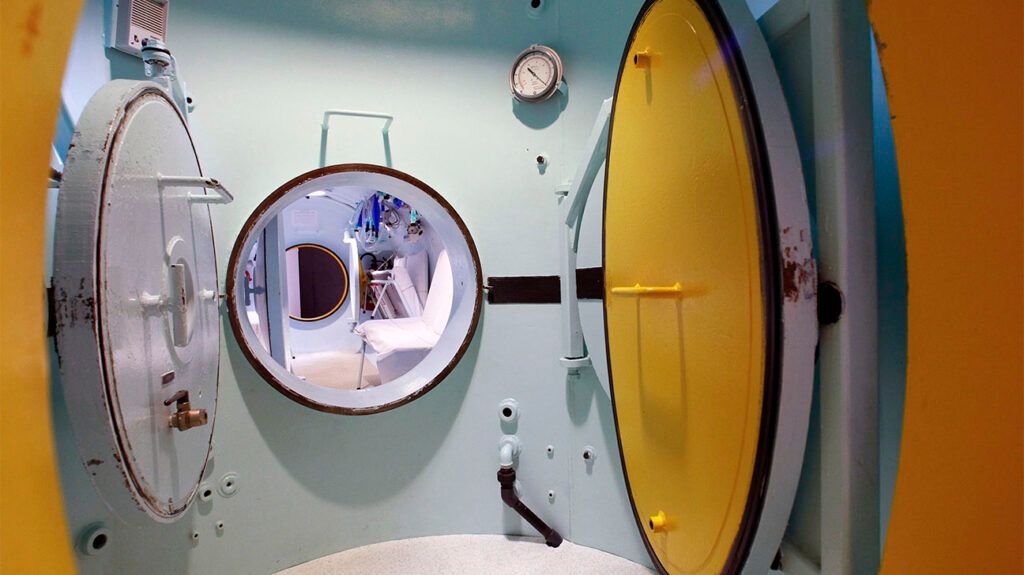Hyperbaric oxygen therapy (HBOT) involves breathing almost pure oxygen in a special room or small chamber.
Hyperbaric oxygen therapy (HBOT) uses a pressurized chamber in which a person is exposed to pure oxygen concentrations at a pressure
The body’s tissues need oxygen to function, and additional oxygen can help damaged tissue heal. Oxygen at high pressure can enhance tissue function and fight infection under certain conditions. Breathing almost pure oxygen at this pressure can increase the concentration of oxygen available to the lungs by up to three times.
There are a

The increase in oxygen concentration and atmospheric pressure in HBOT may be beneficial in several different instances.
- air and gas bubbles in the blood
- decompression illness
- anemia when blood transfusions are not possible
- severe infections of the skin or bones
- severe and large burns
- carbon monoxide poisoning
- acute traumatic ischemia, which may involve a crush injury, for example
- gas gangrene
- complete, sudden hearing loss without known cause
- skin grafts at risk of tissue death
- non-healing wounds such as diabetic foot ulcers
- vision loss, sudden and painless in one eye when due to blockage of blood flow
Unapproved uses
A growing number of providers have started offering HBOT as an alternative therapy and claim that it can help with a wide range of conditions.
HBOT chambers are appearing in various facilities, from hospital outpatient departments to spas. There are even chambers for home use. However, the FDA does not approve HBOT for uses other than those listed above.
The FDA point out that they have not approved HBOT as a treatment for the following:
- asthma
- Bell’s palsy
- sports-related injuries
- depression
- migraine
- HIV
- hepatitis
- heart disease
- multiple sclerosis
- cerebral palsy
- strokes
- Parkinson’s disease
- Alzheimer’s disease
- AIDS
- brain injuries
- spinal cord injuries
A person should only receive HBOT for the approved purposes. Using HBOT for unapproved purposes may worsen the existing ailment.
The body’s tissues need oxygen to function, and additional oxygen can help damaged tissue heal. Oxygen at high pressure can enhance tissue function and fight infection under certain conditions.
The ambient pressure inside the chamber is
HBOT is usually an outpatient procedure. Doctors will recommend a frequency of HBOT use depending on a person’s specific health and condition. For example, some cases of monoxide poisoning may only require one therapy session, while the treatment of non-healing wounds may require
However, in severe cases of burns, infections, vision loss, and other conditions, treatment will occur in a hospital setting.
An HBOT session typically involves:
- sitting or lying in a sealed chamber, either alone or with other people, in which case the chamber will be room-sized
- receiving pressurized oxygen, which may arrive through a mask or a hood
- talking with a therapist or technician during the session, if desired
- possibly listening to music or watching TV to encourage relaxation
In a chamber for one, the person usually lies on a table that slides into a clear plastic tube. The length of the session will depend on the reason for the treatment.
Inappropriate use of HBOT can lead to a number of adverse effects, as it involves oxygen at a high atmospheric pressure.
Adverse effects
Possible
- ears
- sinuses
- eyes, including vision changes and cataracts
- teeth
- lungs
Some people also experience:
- anxiety
- claustrophobia
- increases in blood pressure
- hypoglycemia, or low blood sugar
- pulmonary edema, which involves excess fluid in the lungs
- collapsed lung
- vision changes
In rare cases, oxygen toxicity, or poisoning, can occur. Too much oxygen in the body’s tissues can cause convulsions and other complications. People should not undergo HBOT if they have recently had a cold or fever, or ear trauma. People with a history of tinnitus, middle ear infections, pressure intolerance, or ear surgery may be at risk of ear damage.
Anyone considering HBOT should contact their doctor for advice before undergoing treatment. Seek treatment in an approved facility with trained staff who provide HBOT under FDA-approved conditions.
Unsafe facilities
HBOT chambers that do not comply with FDA approval may be unsafe or unfit for medical use.
Some providers offer the use of “soft” or “mild” chambers.
These have the following disadvantages:
- They are unlikely to sustain the necessary pressure or guarantee the purity of the oxygen, resulting in ineffective treatment.
- A power disruption could cause the chamber to deflate, leading to suffocation.
- There is a risk of explosion and fire, as pure oxygen is highly explosive and flammable.
HBOT can assist in decompression illness, and it can help treat carbon monoxide poisoning and other conditions. The FDA currently approves only 13 uses for HBOT, but some people claim that it can have additional benefits.
People who undergo HBOT for unapproved uses may find that providers lack the appropriate qualifications or that premises are unsafe or ineffective. They may waste money or experience long-term adverse effects.
